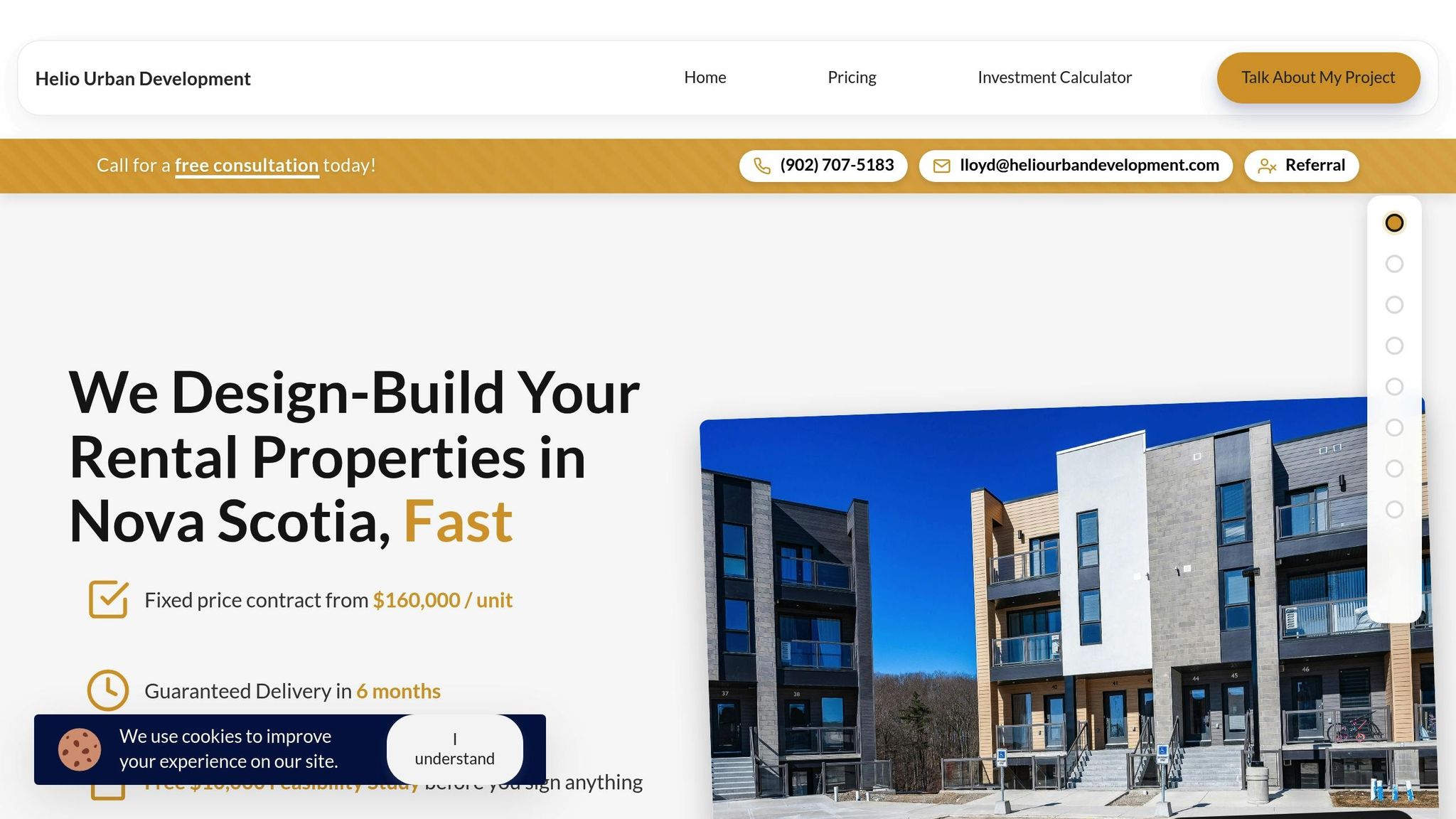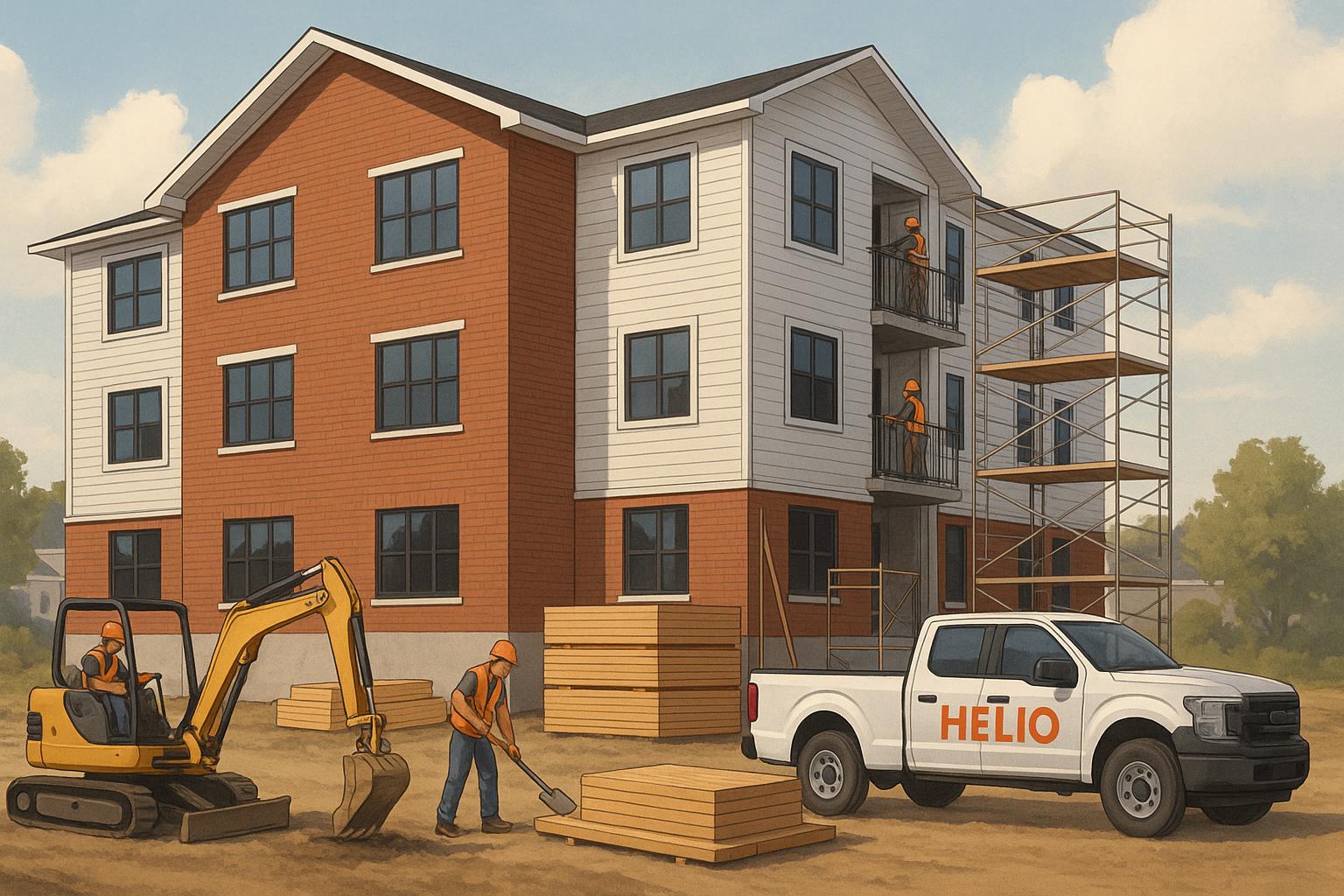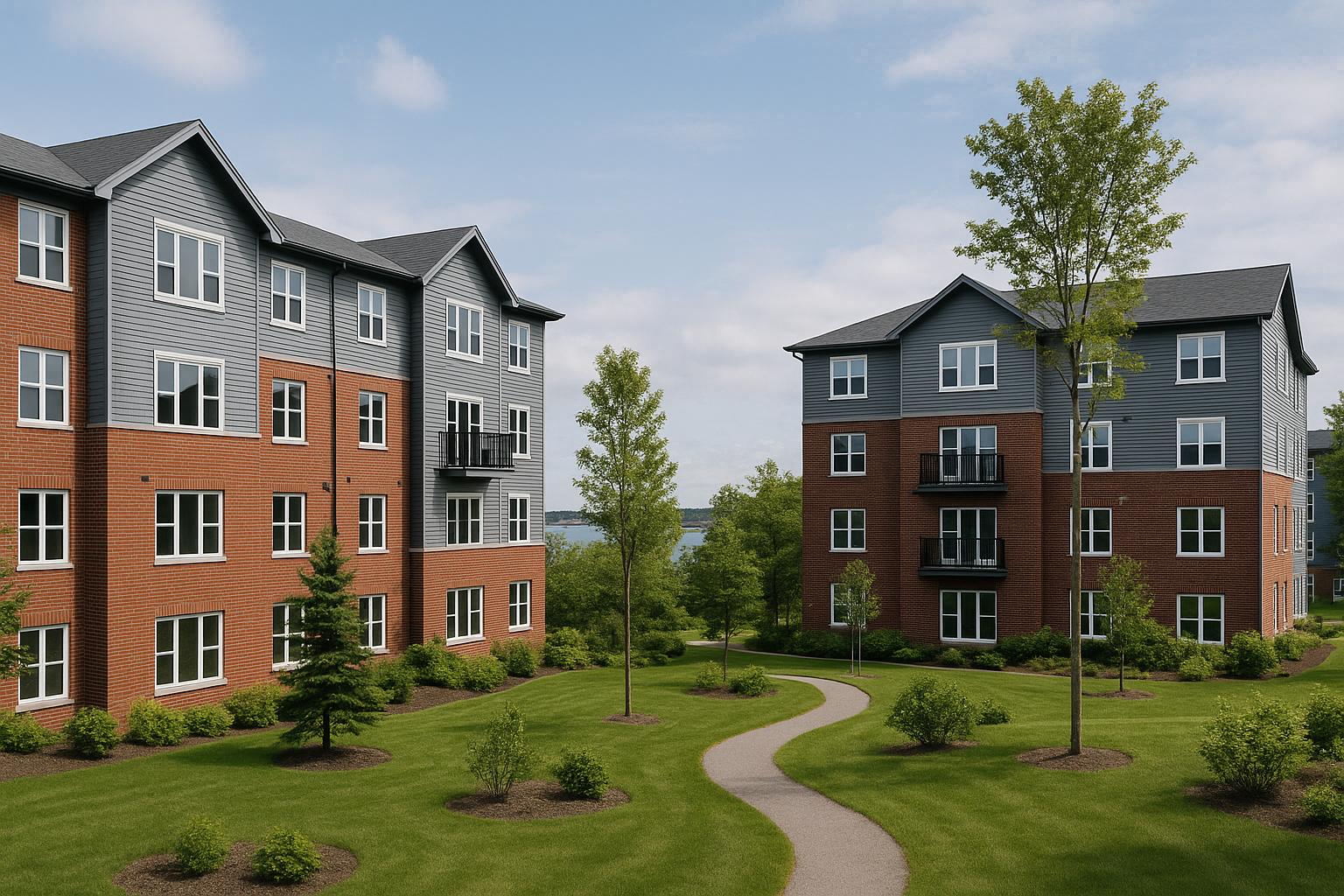If you're planning to build multi-unit apartments in Halifax, understanding the local rules and challenges is key. Here's what you need to know:
- Lot Size and Zoning: Confirm zoning rules with Halifax's planning office. Recent updates allow up to 4 units on residential lots "as of right", and up to 8 units in transit-friendly areas. Rezoning may be required for some projects.
- Utilities: Ensure access to water, sewer, and power. Some areas, especially exurban zones, may lack municipal services.
- Taxes: Multi-unit properties with 4+ units are excluded from Nova Scotia's Capped Assessment Program, leading to higher taxable growth.
- Location Matters: Focus on areas with low vacancy rates and proximity to employment hubs, schools, and transit. Halifax’s rental market is strong due to population growth, with vacancy rates as low as 2.1% in 2024.
- Construction Rules: Follow setback, parking, and height restrictions. For example, 4-unit buildings need 8,000 ft² of lot area and 6 ft side yards, with a height limit of 35 ft.
Choosing a lot is just the first step. Construction methods also matter. Integrated design-build approaches, like those offered by Helio Urban Development, simplify the process, reduce delays, and provide cost certainty. Helio, for instance, charges $160,000 per unit with no cost overruns and guarantees a 6-month timeline.
Careful lot evaluation and streamlined construction planning can save time and money while maximizing your investment.
How to Quickly Look Up Zoning in Halifax, Nova Scotia
What Makes a Lot Suitable for Multi-Unit Apartments
When planning to develop 4–24 unit apartment buildings in Halifax, three key factors will play a major role in determining your project's success: zoning compliance, utility infrastructure, and proximity to high-demand rental areas. These elements directly impact both your construction expenses and the rental income you can expect over time.
Lot Size and Zoning Rules
Zoning regulations in Halifax dictate what types of buildings can be constructed, including specifications for building height, lot size, parking requirements, and density limits [1]. To start, confirm your lot's zoning designation with the local planning office. If the current zoning doesn't permit multi-unit buildings, you might need to apply for rezoning or a special use permit, which can be a lengthy process. For complicated cases, it’s a good idea to consult a zoning attorney or an experienced urban planner [1].
Recent updates to Halifax's zoning laws have created new opportunities. For example, residential lots can now accommodate up to 4 units "as of right", and in transit-friendly urban neighbourhoods, this allowance increases to 8 units. These changes are part of Halifax's "missing middle" housing strategy aimed at addressing housing shortages [2].
Once you understand the zoning requirements, the next step is to ensure the site has the necessary utilities.
Water, Sewer, and Power Access
Reliable access to water, sewer, and electricity is critical for any multi-unit development. Contact Halifax Water and the local electric utility to confirm these connections. This step will also reveal whether any upgrades are needed to support your project.
Distance to High-Demand Rental Areas
After confirming zoning and utilities, the final step is to evaluate the area's rental market. Halifax's population growth has been remarkable, increasing to 492,200 in 2023 - an annual growth of over 19,000 people (+4%) - and surpassing 500,000 in 2024, largely due to international immigration [2]. This population boom has fuelled a strong rental market, with apartment vacancy rates at just 1.0% in 2023, rising slightly to 2.1% by late 2024, still well below the long-term average of 2.7% [2].
For better investment returns, focus on neighbourhoods with vacancy rates under 7% [4]. Halifax's low unemployment rate, which hovers around 5% thanks to growth in industries like tech, finance, and government, further supports consistent rental demand [2].
Rental data shows clear hotspots within the city. Dartmouth North, for instance, had the region's lowest average rents in 2023 (around $1,246) but also experienced extremely tight vacancies. Meanwhile, other parts of Halifax, including Bedford, saw much higher average rents (around $1,922) with vacancy rates as low as 0.5% [2]. On average, renting in Halifax costs about 20% more than in Dartmouth [3]. Additionally, unit turnover in 2024 resulted in a staggering 28% rent increase, the highest in Canada [2].
To maximize your investment, prioritize locations near major employment hubs, universities, and healthcare facilities, ensuring your unit types align with the needs of local renters.
Quick Evaluation Rules for Property Owners
Evaluating your property's potential can feel daunting, but Halifax Regional's basic requirements provide a solid starting point. These straightforward guidelines can help you spot potential red flags early in the process.
Setbacks, Parking, and Driveway Requirements
For duplexes, the minimum requirements include 50 ft of frontage, a total area of 5,000 ft², and 5 ft side yards [6]. If you're considering three- or four-unit buildings, the standards increase to 80 ft of frontage, 8,000 ft² of lot area, and 6 ft side yards [6]. Additionally, the building's footprint must stay within 35% of the total lot area. For example, on an 8,000 ft² lot, the maximum footprint would be approximately 2,800 ft² [6].
Parking rules in Halifax have become more relaxed due to recent housing reforms. Residential developments within the urban service area no longer require on-site parking [5]. However, if you do include parking, each space must measure at least 8 ft by 16 ft [6].
For older buildings constructed before 1959, the rules are more lenient. A duplex conversion with up to six habitable rooms requires a minimum lot size of 3,300 ft², while conversions with up to eight rooms need 4,000 ft². Keep in mind, the building's height, volume, and external dimensions must remain unchanged from their state as of October 25, 1985 [6].
Once you confirm that your lot meets these dimensions and parking standards, the next step is to check building size and height restrictions.
Maximum Building Size and Height Limits
While most height restrictions have been lifted, buildings with three or four units are still limited to a maximum height of 35 ft [6].
For larger developments, density rules have also shifted. Projects that begin construction before April 1, 2027, will calculate density based on the lot's gross area rather than its net area, as outlined in the Conservation Design Development policies [5].
After ensuring your lot meets these physical requirements, it's crucial to be aware of potential regulatory challenges.
Common Lot Problems to Avoid
Certain zoning classifications - such as industrial, military, park, transportation reserve, utility, environmental protection, water supply, and floodplain zones - do not permit residential use. Double-check your zoning to avoid costly issues [5].
Additionally, for multi-unit residential buildings starting construction before April 1, 2027, the requirement for ground-floor commercial space has been temporarily removed. Previously, ground floors had to include more than 20% commercial space, but this rule no longer applies, giving you more flexibility in your project timeline [5].
sbb-itb-16b8a48
Permits and Required Documents
Once you've assessed your lot, the next step is securing the necessary permits to keep your project moving smoothly. Getting the right paperwork in place can save you months of delays and thousands of dollars. The Halifax Regional Municipality (HRM) has simplified many processes, but knowing exactly what you need is key. Start by using HRM's online tools to confirm the buildable parameters of your lot.
How to Check What You Can Build on Your Lot
HRM offers an online mapping system at halifax.ca. By entering your property address, you can find details like zoning designation and overlay restrictions. This tool provides information on zoning, setback requirements, and height limits specific to your property.
For more formal documentation, request a Zoning Confirmation Letter from HRM. This letter outlines zoning details, density allowances, and any special conditions for your lot. It’s often required for construction financing, so it’s worth confirming fees and processing times with HRM.
If your lot has unique features like steep slopes, wetlands, or a heritage designation, consider booking a pre-application consultation with HRM planning staff. These meetings can help you identify potential challenges - such as environmental restrictions or utility easements - before you invest in detailed plans.
Required Permits and Construction Documents
To apply for a construction permit, you’ll need to prepare several key documents:
- Site Plan: This should detail existing conditions and proposed changes, including setbacks, parking areas, and stormwater management. A qualified surveyor should prepare this plan to ensure accuracy, with fees varying based on project complexity.
- Architectural Drawings: These include floor plans, elevations, building sections, and construction details. They must be stamped by a licensed architect or engineer in Nova Scotia, with fees depending on the scope of your project.
- Grading and Drainage Plan: This document shows how surface water will flow around your building and connect to municipal systems. It ensures your development won’t cause flooding for neighbouring properties and is usually prepared by a civil engineer.
- Structural Drawings: For multi-unit buildings, structural drawings approved by a professional engineer are mandatory. These include details on foundations, framing, and load calculations. Costs for these services will depend on the specifics of your project.
Building permit fees are calculated based on your project’s total construction value. Once you’ve submitted all required documents, the review process typically takes several weeks. Be sure to check HRM’s fee schedule for the latest rates and timelines.
Construction Inspection Schedule
Throughout the construction process, HRM requires several inspections to ensure compliance with approved plans. These inspections include:
- Foundation Inspection: Conducted after excavation and formwork but before pouring concrete. Inspectors check foundation depth, reinforcement placement, and drainage.
- Framing Inspection: This happens after the structural frame is complete. It ensures the work aligns with the approved drawings and that critical connections are properly installed.
- Rough‐In Inspections: These cover plumbing, electrical, and HVAC systems before insulation and drywall are installed. Each trade is inspected separately, and all work must be completed by licensed contractors.
- Insulation and Vapour Barrier Inspection: This confirms that thermal barriers and air-sealing measures are correctly installed to improve energy efficiency and prevent moisture problems.
- Final Inspection: Once all construction is complete - including flooring, fixtures, and exterior finishes - inspectors verify that the building meets approved plans and safety standards. An occupancy permit is issued once everything checks out, allowing tenants to move in.
Schedule inspections in advance using HRM’s online system. If inspectors find deficiencies, a re-inspection will be needed, which can incur additional fees and delay your project.
With permits in hand and documents prepared, you’ll be ready to move forward with a well-organized construction process.
Integrated vs. Traditional Construction Methods
When planning multi-unit apartments in Halifax, the construction method you choose can make or break your project. This decision is especially critical when evaluating a lot's potential for multi-unit development. Traditional construction methods often leave property owners juggling multiple independent contractors, dealing with unexpected costs, and enduring delays that can stretch a project from 8 months to well over 18 months. On the flip side, integrated design-build brings all professionals under one contract, simplifying communication and ensuring accountability.
Design-Build vs. Traditional Construction Comparison
Traditional construction typically involves property owners managing six or more separate professionals - architects, engineers, general contractors, subcontractors, and other specialists. This fragmented setup often leads to communication breakdowns and cost overruns ranging from 30% to 60%.
In contrast, design-build construction operates with a fixed-price contract established before construction begins. This approach eliminates budget uncertainty, as the builder absorbs any cost overruns. Additionally, while traditional projects may face lengthy delays of 8 to 18+ months, integrated design-build teams can complete projects in as little as 6 months. To keep timelines on track, financial penalties are often included if deadlines are missed.
| Factor | Traditional Construction | Design-Build Integration |
|---|---|---|
| Contracts | 6+ separate agreements | Single contract |
| Cost Certainty | Cost-plus pricing with 30–60% overruns | Guaranteed fixed-price |
| Timeline | 8–18+ months typical | 6 months with penalties |
| Accountability | Finger-pointing between trades | Single point of responsibility |
These distinctions show how an integrated approach not only locks in pricing but also improves project coordination and efficiency.
Unlike traditional methods, integrated teams address potential conflicts during the design phase, significantly reducing the likelihood of costly on-site changes. When specialists work independently, coordination issues often arise, leading to expensive corrections.
How Helio Urban Development Handles Multi-Unit Projects

Integrated construction methods, paired with thorough lot evaluation, can resolve many of the challenges property owners face. Helio Urban Development is a prime example of how this approach avoids the pitfalls of traditional methods. By bringing planners, architects, engineers, and construction teams together under one roof, Helio eliminates the coordination issues that often add unnecessary costs - estimated at about $47,000 per multi-unit project.
Helio's fixed-price construction model, set at $160,000 per unit, ensures complete budget certainty, with no recorded cost overruns across their 31 completed units. They also offer a 6-month construction guarantee, with financial penalties of up to $1,000 per day for missed deadlines, ensuring projects stay on schedule.
"I guarantee every timeline because I've experienced construction delays", says Lloyd Liu, Helio's co-founder and CEO.
Helio's success highlights the effectiveness of a streamlined, integrated system. Co-founder Yuan He developed a scheduling optimization system that keeps all work aligned with a master schedule managed by a single team. This approach prevents the delays often caused by coordinating multiple independent contractors.
To ensure quality, Helio employs a triple-inspection process. A Professional Engineer conducts five inspections during construction, municipal inspections are completed by the Halifax Regional Municipality, and property owners can bring in their own inspector for a final review. Daily photo updates, accessible through a dedicated project portal, provide complete transparency into the progress of each build.
With 131 units currently in planning across Nova Scotia and active projects underway from Antigonish to Bridgewater, Helio demonstrates how a structured, integrated approach can keep projects on track and within budget.
Conclusion: Streamlined Lot Evaluation and Construction
Evaluating lots in Halifax for multi-unit apartments goes beyond simply checking zoning regulations or measuring square footage. To set the stage for a profitable rental property, property owners need to follow key evaluation steps - like confirming setbacks and ensuring utility capacity. But remember, this is just the beginning. The real challenge lies in navigating the often-complicated construction phase.
Once the lot evaluation is complete, your construction strategy becomes the driving force behind long-term success. Relying on traditional construction methods often means juggling numerous contractors, dealing with unexpected budget overruns, and coping with delays that push back rental income. In contrast, integrated construction methods tackle these pain points head-on. They bring consistency by using controlled environments, improve cost predictability with bulk purchasing and streamlined processes, and cut down timelines by allowing off-site work to progress alongside on-site preparation [7].
Pairing a thorough lot evaluation with an integrated construction partner, like Helio Urban Development, can significantly reduce the unpredictability of multi-unit projects. Helio’s proven record highlights how a systematic approach can replace the guesswork and inefficiencies of fragmented construction, giving property owners the confidence to move forward with their projects.
FAQs
What are the advantages of choosing a design-build approach for multi-unit apartment projects in Halifax?
Choosing a design-build method brings several clear benefits for multi-unit apartment projects in Halifax. This approach combines both design and construction under a single team, which helps improve communication and teamwork. By cutting down on miscommunication and streamlining the process, it often leads to quicker project completion and can help keep costs in check.
Another major advantage is better handling of risks. When the design and construction teams collaborate early on, potential issues - like zoning restrictions or utility access - can be spotted and resolved before they become costly problems. This proactive approach leads to smoother, more predictable project outcomes. For property owners navigating Halifax's rental market, the design-build model offers an efficient and reliable solution.
What do Halifax's new zoning laws mean for building multi-unit apartments on residential lots?
Recent changes to Halifax's zoning laws aim to tackle the region's growing housing shortage by increasing housing density. Under the new rules, property owners can now build up to 8 units on lots that were previously restricted to single-family homes. Additionally, taller buildings are permitted in areas close to universities and colleges.
These updates simplify the process for property owners to create multi-unit housing, especially in urban neighbourhoods. By encouraging denser developments, the reforms pave the way for smaller-scale apartment projects, addressing the city's rising demand for rental housing.
What should property owners in Halifax consider when choosing a lot for building multi-unit apartments?
When you're picking a lot for multi-unit apartments in Halifax, there are a few key factors to keep in mind. Start with zoning regulations - for example, ER-3 zoning allows up to eight units per lot without requiring rezoning. This can save you time and effort down the line. Next, consider the lot size and frontage, as these will determine how many units you can actually build.
It's also important to think about the location's proximity to high-demand rental areas. Being close to amenities, schools, or public transit can make your property more appealing to tenants. Lastly, ensure there’s easy access to utilities like water, electricity, and sewage, which are essential for both construction and tenant satisfaction.
Picking the right lot not only keeps you aligned with local rules but also maximizes your rental potential and simplifies the approval process. By weighing these factors carefully, you’re setting yourself up for a smooth and successful development project.
Related Blog Posts
- Halifax’s New Zoning Rules Explained: Up to Four Units on a Single Lot (What It Means for Builders)
- Halifax 3-Storey Apartments: ER-3 Maximum Height Without Variance
- ER-3 (ER3) Builder Halifax: How Many Units Fit on a Typical Lot?Halifax Apartment Builder: 4–12 Units Without Rezoning
- Which Halifax Lots Become 6–8 Units Most Easily?



